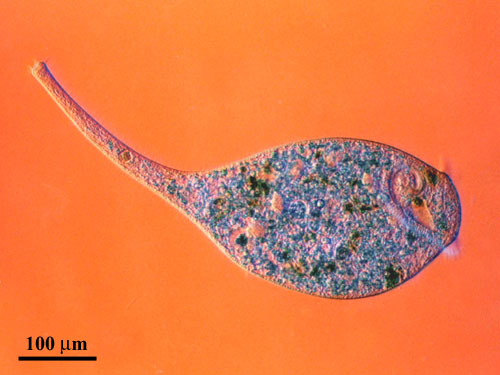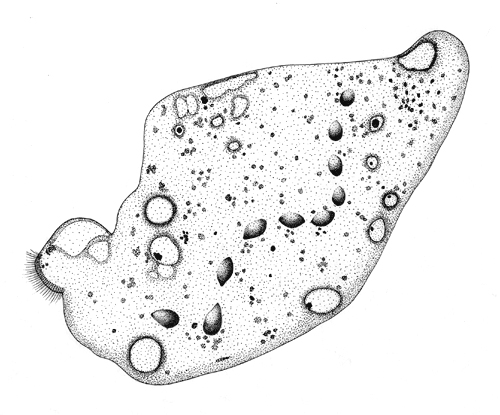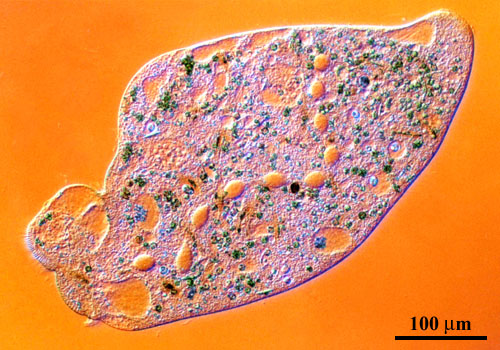
|
of Stentor |

|
Line drawing by Kunthida Tungthongchaiviriya, Thailand

|
of Stentor |

|
One of the important organellae of eukaryotic organisms is the nucleus. Its name derives from the Latin that means kernel or seed. Except for prokaryotic life such as bacteria and blue green algae possessing a nucleoid region, all eukaryotes like protists, fungi, plants, and animals have a nucleus in their cell. The genetic material, DNA (deoxyribonucleic acid), is kept within this double membrane bound organelle and can be inherited in descendants by the process of reproduction.
Generally, a single cell has one nucleus but many types of cells such as skeletal muscle cell, etc. and many types of organisms such as ciliated protozoa, etc. occupy more than one nucleus. Although most nuclei are either round or oval in shape, a number of them in some organisms have strange shapes and different numbers.
From the protozoological point of view, the number, shape, size, and position of the nucleus are significant and useful features for protozoan identification to genus and species level. This article describes and illustrates a kind of protozoan nucleus situated in a well-known giant ciliate, Stentor (Figure 1). For detailed and comprehensive information of the genus, please read further from Lynn, D.H. 2002. The Ciliate Resource Archive.

Figure 1. A whole cell of Stentor in maraca-shaped form. (Taken by D.I.C.; objective 10X.)
In addition to possessing cilia as a locomotory structure once in their life cycle, ciliates are characterized by having two types of nuclei, a micronucleus and macronucleus, therefore members of this protozoan group are sometimes called heterokaryotic organisms. The micronucleus is small and commonly possesses a spherical shape. It has a vital function concerning the regulation of any sexual process of ciliates such as conjugation. The macronucleus is larger and has various shapes, from a simple round form to a dendritic one depending on the species. The macronucleus has major duties in regulation of any somatic or vegetative process of the organism such as nutrition, metabolism, RNA synthesis, morphogenesis, regeneration, etc. Broadly speaking, it controls any asexual mechanism occurring in the ciliate cell. One of those several macronuclear shapes is called moniliform. The term indicates its necklace shape (Latin monile, necklace or bead; forma, shape). This macronucleus is located within and along subvertically Stentor's living body. It is composed of a number of nodes and lines and connects continuously to be a bead string (Figure 2 and 3).

Figure 2. A line drawing shows ten nodes of a moniliform macronucleus of Stentor.
Not only Stentor adopts this macronuclear type, but so also do various ciliate species such as Blepharisma americanum, Dileptus cygnus, Dileptus monilatus, Loxophyllum meleagris, Metafolliculina producta, Pebrilla paguri, Spirostomum ambiguum, Stentor coeruleus, Stentor introversus, Stentor muelleri, Stentor polymorphus, etc.
At the moment, no one knows what factors regulate the various and different forms of macronuclei in each ciliate species. It is still one of nature's mysteries awaiting further research and future discoveries.

Figure 3. A living Stentor flattened by absorbing excessive watery surrounding medium clearly shows its necklace-shaped macronucleus. (Taken by D.I.C.; objective 10X.)
![]()
Comments to the author, Chitchai Chantangsi, are welcomed.
Glossary for some scientific words in this article:
| eukaryote | : an organism possessing nuclear membrane; also eucaryote |
| heterokaryotic | : having different types of nuclei like macronucleus and micronucleus |
| macronucleus | : larger one of two sized nuclei in ciliated protozoa; also meganucleus, trophonucleus |
| micronucleus | : small nucleus of two sized nuclei in ciliated protozoa |
| morphogenesis | : the formation or development of shape and part of organism |
| nucleoid region | : an area having genetic material in prokaryotic cell |
| prokaryote | : an organism lacking nuclear membrane; also procaryote |
| regeneration | : renewal of a part of body which has been injured or lost |
Acknowledgement:
I would like to express my gratitude to Professor Dr. Denis H. Lynn and Professor Dr. David J. Patterson for valuable information about the macronucleus. The kind permission of Prof. Lynn in putting a link from this article to his comprehensive ciliate archive would be acknowledged by the author. Finally, I am indebted to Dave Walker for his kind amendments to this article.
Please report any Web problems or offer general comments to the Micscape Editor.
Micscape is the on-line monthly magazine of the Microscopy UK web site at Microscopy-UK